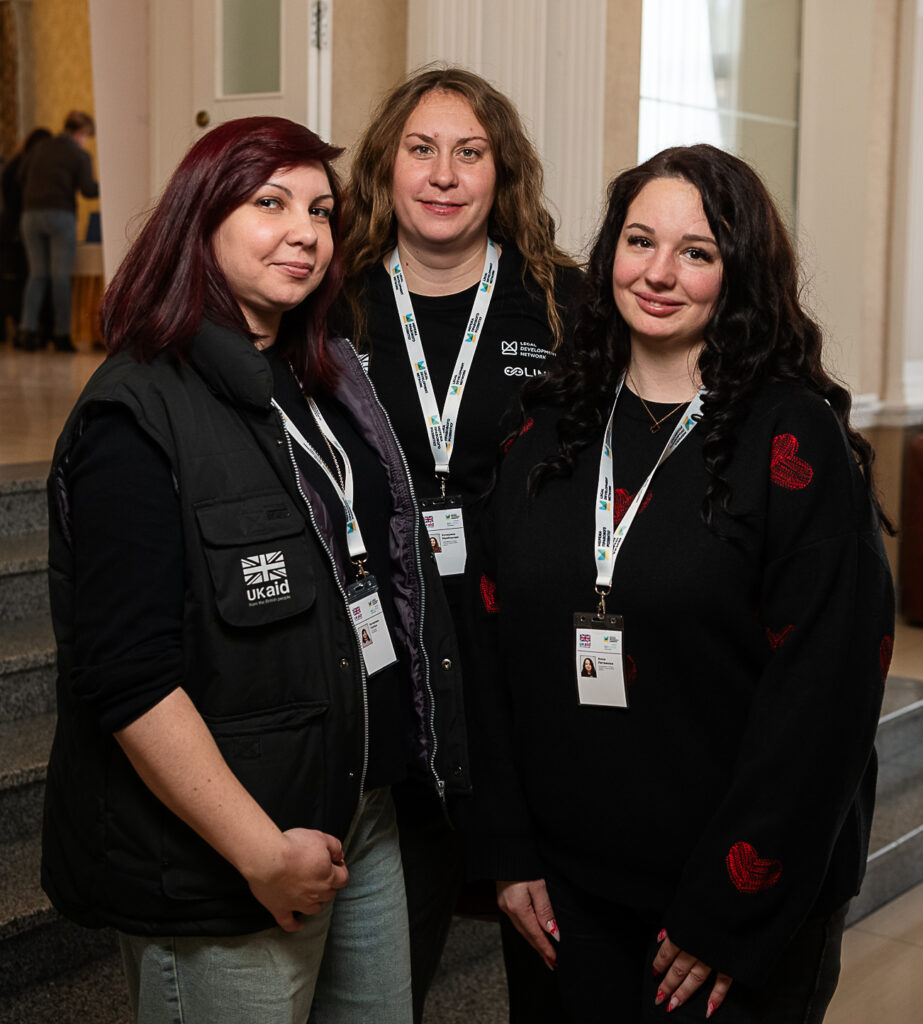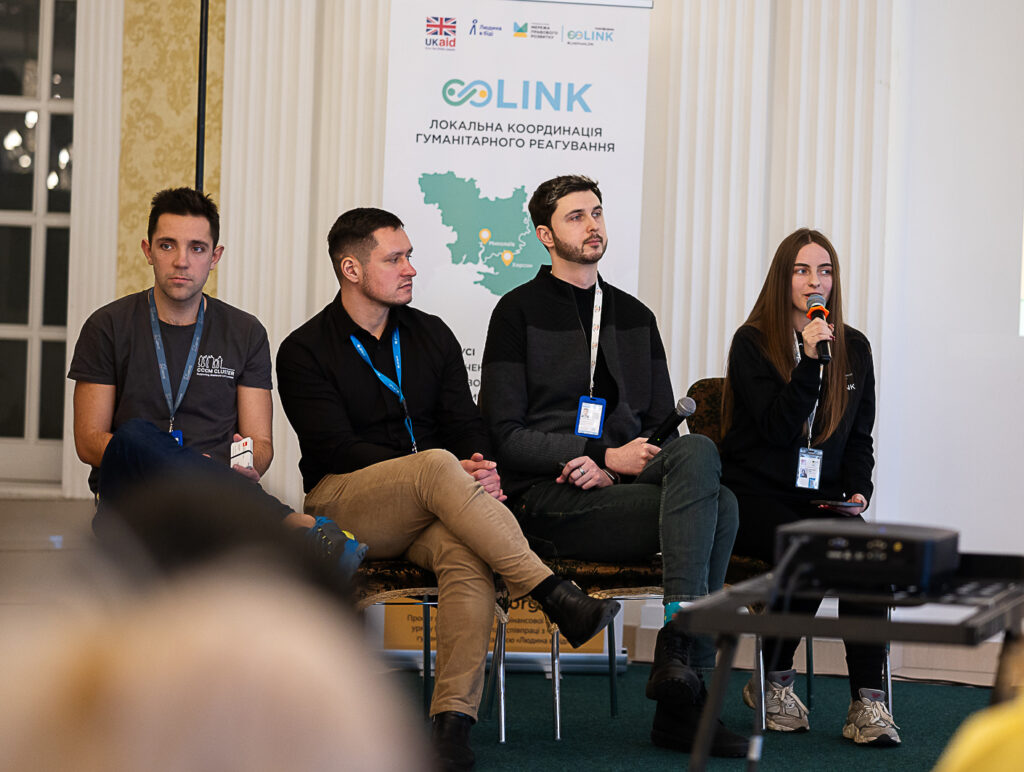Link: joining forces to provide effective assistance to de-occupied communities in Mykolaiv and Kherson oblasts
Publication date: January 24, 2025
Author: Halyna Kolesnyk, Head of the Communication Cluster of the Legal Development Network
Since the beginning of 2023, the Legal Development Network, in partnership with the Czech humanitarian organization People in Need and with funding from the UK government, has been implementing a mechanism for local coordination of humanitarian response in the de-occupied communities of Mykolaiv and Kherson regions. The opportunities Link offers today and what has been achieved in synergy with partners were discussed at a public presentation and discussion in mid-January 2025.
“Link is proving to be a successful, timely and promising approach to Ukraine’s recovery. Together with our allies and partners, we provide people with comprehensive support – from humanitarian aid to legal protection. This makes it possible to systematically restore the lives of communities affected by the war,” emphasizes Olga Nastina, Executive Director of the Legal Development Network.
As of January 2025, more than 4, 500 unnoticed and unmet needs have been identified in 332 settlements of 24 de-occupied communities. More than 700 needs have been addressed either in full or in part thanks to partner organizations.
“Our CRM system does more than just record needs — it creates a bridge between those who need help and those who can provide it. Each need is thoroughly verified by at least two sources before it is posted to the public dashboard. This guarantees the relevance and reliability of the information,” says Oleksiy Tertyshnyi, project manager of the Legal Development Network, explaining the uniqueness of Link’s approach.
The platform is constantly adapting to changing conditions. About 25% of the recorded needs lose their relevance due to various factors: seasonality, migration, changing community priorities. This requires constant data updating and close cooperation with local informants — more than 800 active citizens regularly provide updated information about the needs of their localities.
The platform operates through three interconnected components:
- Public dashboard — allows you to book needs for fulfillment,
- Community Cabinet — a tool for managing needs at the local level,
- The Partner’s Cabinet is a space for effective coordination of assistance.
Innovative technological solutions
The Community Cabinet allows local government representatives to:
- Enter information about the current needs of their communities
- Track the status of applications in real time
- Receive up-to-date information on the delivery of aid
- Manage the database of community needs
- Generate analytical reports
- Coordinate work with various aid providers
ThePartner’s Cabinet provides humanitarian organizations with the opportunity to:
- See the current needs for each community and settlement
- Reserve needs for fulfillment
- Coordinate their activities with other organizations
- Receive detailed information about the situation on the ground
- Plan the logistics of aid delivery
- Track the results of the assistance provided
All the benefits of community and partner accounts can be used after registration and verification of user data by the Link platform team.
Practical implementation of the Link local coordination mechanism
“We are taking care of 13 communities, which is 217 settlements. There are settlements where three, five, eight people live, but we are present there,” says Tetyana Tymoshyna, coordinator of the humanitarian response team in Mykolaiv and Kherson regions, demonstrating that the team is committed to leaving no one behind. It is particularly important that the team has identified settlements with critical needs, for example, where there is no water supply at all, as in some villages of the Ingul community.
LINK has three key functions:
- Collecting unmet needs:
- Identifying gaps in assistance
- Monitoring of emerging needs
- Special attention to remote and sparsely populated locations
- Data verification:
- Verifying the accuracy of information from two or more sources
- Documentation of needs
- Entering verified data into the platform
- Search for partners:
- Coordination with assistance providers
- Facilitating rapid response
- Logistics support for the distribution of aid.
“In order to make the mechanism of collecting and verifying needs work, we have established communication with communities, community leaders, social workers, and starostas who have information about the needs of their community. We also cooperate with volunteers, concerned residents, and public organizations,” explains Tetyana Tymoshyna.
Tetyana Tymoshyna explains how the mechanism helps to meet the needs of the community in a timely manner, citing several cases.
During a visit to the village of Nove Zhyttia in the Ingul community of Mykolaiv Oblast, the team learned that there was a person with a disability who lived in an unheated house and needed medical care.
“We contacted a partner organization… Three days later, the person received medical care and then housing. She was placed in a shelter,” says Tetyana Tymoshyna.
Recently, five houses in the village of Prybuzke, Halitsynivka community, were damaged by an explosion, and the families who lived in them were left homeless. They were relocated to unheated houses… The Link team contacted two organizations — DRC and Javelin — who quickly responded and helped.
Another example is the Berezneguvate community. Since the beginning of the full-scale invasion, residents of the two villages of Petropavlivka and Novoochakiv have not received hygiene kits, although they need them. Currently, through Link, humanitarian aid is being sent to each village of the Berezneguvata community through the partners of the Pomogayem Charitable Foundation, SOS Children’s Village and Water Mission.
“I would like to say that we now have very inclusive information about the situation in each settlement: the number of children, their age, how many schoolchildren, how many people with disabilities, what potential the village has, and, of course, what needs it has. This information can help us in the future when we are rebuilding our country,” emphasizes Tetyana Tymoshyna, coordinator of humanitarian response teams in Mykolaiv Oblast.
Using the LINK platform allows even small organizations to achieve significant results in supporting affected communities.
“Javelin is a small organization that started working in 2022. We were created, like probably most teams, to help those affected by Russia’s full-scale war against Ukraine,” says Aliona Petrykovets, a volunteer responsible for logistics at Javelin.
The foundation works with several communities, focusing on the most affected areas: Shyrokivka, Shevchenkove, Pervomaiske, Halytsynivska communities in Mykolaiv region.
The volunteer notes that by coordinating through the LINK platform, the foundation can allocate resources more efficiently.
“It seems to me that if this platform had started working in 2022, we, ordinary volunteers, would have been able to help much more in Mykolaiv and Kherson regions, because there were a lot of double counting back then. Through Link, we avoid duplication of aid – if charitable organizations have blankets, they no longer take them to the same village, but distribute them to those settlements where it is really needed,” emphasizes Aliona Petrykovets.
Challenges and solutions in humanitarian response
In the frontline areas of Kherson Oblast, where the humanitarian situation remains difficult, effective coordination of aid is of particular importance.
Oleksandr Gonchar, coordinator of the humanitarian response team in Kherson region, shares his experience: “At the moment we are taking care of Chornobaivka and Muzykivka communities… We are present in this 10-kilometer zone and in the city of Kherson.“

Despite the difficult security situation, the team continues to work as close to the front line as possible. Working in the frontline area poses special challenges.
“The logistics issue of how to get to other communities remains a difficult issue for all Kherson residents,” the coordinator notes.
Despite these difficulties, the team finds ways to be present where their help is most needed.
The coordinator pays special attention to the need for a systematic approach to providing assistance: “During the war, all communities near the front line are affected. That is why the aid should come on a regular basis and have a stabilizing and permanent support.”
Yulia Stadnyk (Zelenodolsk, Dnipro oblast), coordinator of the humanitarian response team in Kherson region, who is in charge of eight communities, adds to the list of challenges.
“The first challenge we faced… is, of course, the security situation. We collect and analyze data, and then invite partners to cooperate, taking into account the security situation, where you can and cannot get to. After all, most of our communities have one or two conditionally safe settlements, and all the rest are under constant shelling,” says the coordinator.
Another challenge Yulia Stadnyk also mentions is logistics. This includes off-road conditions and other obstacles, such as the lack of appropriate transport for small organizations, and for large partners – security restrictions and the inability to access large vehicles.
“The third issue we faced… is the huge number of needs. When we receive lists of 100, 200, a thousand needs, we sit and think, what should we do with this?” says Yulia Stadnyk.
The range of needs includes:
- Water supply systems
- Restoration of damaged housing
- Assistive devices for people with disabilities
- Permanent needs for hygiene products
Yulia Stadnyk notes that different organizations have problems with resources, with large organizations lacking human resources and small ones needing financial resources. But despite the many challenges, the team manages to achieve results in helping communities.
One example of such effective cooperation is meeting the needs of the Velyko Oleksandrivska community in Kherson Oblast. Through the Link mechanism, the team managed to find partners who provided hygiene kits, medicines, rehabilitation equipment, and drinking water.
The community has 34 settlements and was under occupation from March to November 2022. During the occupation, only 2000 of 16239 residents remained. Now 11240 people have returned. In addition, 1878 internally displaced persons have found refuge there. The settlements along the Ingulets River were particularly affected.
“Our community is located on the bank… This was the border for the occupiers, they held our settlements on the contact line. Some settlements were completely destroyed. For example, the village of Bilohirka… After its complete destruction, 12 houses have been restored there today, people have returned there, and we must support them,” emphasizes Svitlana Pashniuk, head of the social work sector of the Velyko Oleksandrivka community.
She also notes the great contribution of organizations that helped after the de-occupation.
“I thank the Link platform for highlighting our needs for the funds, because we can’t do it without them,” summarizes Svitlana Pashniuk.
Tetyana Lisna, coordinator of the humanitarian headquarters in the Chornobaivka community in Kherson Oblast, also notes the Link mechanism’s assistance in uniting efforts to respond to humanitarian challenges. She also emphasizes the need to quickly acquire new knowledge about the functioning of the humanitarian response system.
Understanding how local coordination and the UN cluster system work helps communities better manage their needs.
Synergy with the UN cluster system

“When there is a crisis or military action, a war, we see that a lot of organizations, NGOs, international or UN agencies, volunteers are actively involved in supporting the affected population. This creates certain gaps or duplication, so there is a need for such a tool as a cluster system of aid coordination,” explains Serhiy Gusak, Regional Coordinator of the Water, Sanitation and Hygiene Cluster.
There are 11 clusters in the world, of which 9 are active in Ukraine. Each cluster has a clearly defined area of responsibility and tasks. It is important to understand that clusters do not directly fund projects or delegate tasks; they create a platform for coordinating the efforts of different organizations.
Water, sanitation and hygiene (WASH)
Serhiy Gusak, cluster coordinator, describes three strategic areas:
- Access to safe water:
- Supporting utility companies
- Repair of water pipes
- Ensuring water treatment
- Solid waste management
- Support for central heating
- Hygiene:
- Supporting vulnerable households
- Strengthening hygiene practices
- Provision of drinking and process water
- Support to institutions:
- Provision of hospitals
- Support to places of compact settlement
- Support for schools
“According to our statistics, about 40% of water utilities and their networks were in a critical unsatisfactory condition even before the full-scale invasion,” said Serhiy Gusak.
Protection of the affected population
The Protection Cluster coordinated by UNHCR brings together more than 100 organizations across the country. Oleh Topchiev, Regional Protection Cluster Coordinator in Odesa Hub, emphasizes the importance of information exchange:
“In the southern hub, we have about 85 reporting partners. The cluster can serve as a platform for disseminating activities about your organization and participates in referrals through the service mapping platform.”
The Service Mapping Platform contains information on international and national NGOs and UN agencies providing protection services, the working group on cash assistance, shelter and non-food items, coordination and management of temporary accommodation and food security and livelihoods.
The Protection Cluster includes three sub-clusters:
- Mine action
- Gender-based violence
- Child protection
In addition, they work through specialized groups:
- Legal Aid Working Group
- Working group on case management
- Technical working groups:
- On housing, land and property issues
- On age and disability issues
- On issues of LGBTQ+ communities
- Working group on combating human trafficking
Temporary accommodation management
The youngest of all the clusters, CCCM (Camp Coordination and Camp Management), was activated in 2022 in response to the massive displacement of people. Yaroslav Matyash explains:
“At the hottest and most difficult times, i.e. March, April 2022, approximately 2 million people were living in temporary accommodation. At the moment, this figure is about 80 thousand.”
Coordination tools
Each cluster has developed its own information tools for effective coordination:
- WASH has created an interactive map of water utilities and a system for monitoring the need for hygiene kits.
- The Protection Cluster maintains several information dashboards to track partner activities and monitor the situation
- The CCCM conducts detailed monitoring of temporary accommodation with more than 200 indicators and manages information on the needs in temporary accommodation.
“Coordination and cluster approach does not imply delegation of tasks and direct implementation. It is a tool for better organization, professionalism, orderliness and predictability of humanitarian response,” summarizes Serhiy Husak.
At a time when humanitarian needs remain significant and resources are limited, effective coordination is key to maximizing the impact of aid on the lives of the affected population. The cluster system provides a platform for such coordination, and the success of this approach depends on the active participation of all humanitarian organizations.
In the field of humanitarian assistance, it is especially important to avoid duplication of efforts and ensure maximum coverage of needs.
“We conduct a systematic analysis of needs together with UN clusters. If we find duplication, we carefully analyze the reasons and adjust our data. This allows us to optimize the allocation of resources and speed up the provision of assistance. Our goal is to work synergistically with all humanitarian aid providers to maximize coverage of the needs of the de-occupied territories. Each covered need is a step towards restoring normal life in the affected regions,“ emphasizes Oleksiy Tertyshnyi.
If you have notices an error on the web-site, please, highlight the text and press ctrl-enter.
Have you found your solution? Help others!
Print a poster
Print and place the Network's poster on a notice board in your entrance hall
Become a volunteer
Become a volunteer and assist others in finding problem solutions
Do you need a consultation ?
Online chat
Ask question and one of the LDN's lawyers
will answer it.
Chat's schedule: from 10 to 16
every day
Chatbot
Ask questions via LawLink Bot in any convenient way. LawLink Bot is a smart and digital legal assistant created by the Legal Development Network.

Our initiatives
The Legal Development Network implements comprehensive projects aimed at strengthening human rights, developing capable communities, and building sustainable tools for access to legal aid. We work at the intersection of advocacy, legal education, and local coordination of humanitarian response.
